Ship's cat
.jpg)


The ship's cat has been a common feature on many trading, exploration, and naval ships dating to ancient times. Cats have been carried on ships for many reasons, most importantly to catch mice and rats. These vermin aboard a ship can cause damage to ropes, woodwork, and more recently, electrical wiring. Also, rodents threaten ships' stores, devour crews' foodstuff, and could cause economic damage to ships' cargo such as grain. They are also a source of disease, which is dangerous for ships that are at sea for long periods of time. Notably, rat fleas are carriers of plague, and rats on ships were believed to be a main spreader of the Black Death.
Cats naturally attack and kill rodents,[1] and their natural ability to adapt to new surroundings made them suitable for service on a ship. In addition, they offer companionship and a sense of home, security and camaraderie to sailors away from home for long periods, especially in times of war.
Early history
.jpg)
The domestication of cats is believed to date back to around 9,000 years ago on farms in the Near East. The Ancient Egyptians took cats on board Nile boats to catch birds in the thickets along the riverbanks.[2][3] A 2017 mitochondrial DNA study suggests that cats spread from ancient Egypt along maritime trade routes a few thousand years after first being domesticated.[4] Preliminary results of a genetic study published in September 2016, concluded that cats were also carried on trading ships to control rodents, and that practice was adopted by traders from other nations, including Vikings in northern Germany around the 8th to 11th centuries.[5] Ever since, the domestic cat has spread from ports to homes across the world.
Cats and superstition
Sometimes worshipped as deities, cats have long had a reputation as magical animals and numerous myths and superstitions sprang up amongst the unusually superstitious seafaring community.[6] They were considered to be intelligent and lucky animals, and a high level of care was directed toward them to keep them happy. Some sailors believed that polydactyl cats were better at catching pests, possibly connected with the suggestion that extra digits give a polydactyl cat better balance, important when at sea. In some places polydactyl cats became known as "ship's cats".
Cats were believed to have miraculous powers that could protect ships from dangerous weather. Sometimes, fishermen's wives would keep black cats at home too, in the hope that they would be able to use their influence to protect their husbands at sea. It was believed to be lucky if a cat approached a sailor on deck, but unlucky if it only came halfway, and then retreated. Another popular belief was that cats could start storms through magic stored in their tails. If a ship's cat fell or was thrown overboard, it was thought that it would summon a terrible storm to sink the ship and that if the ship was able to survive, it would be cursed with nine years of bad luck. Other beliefs included, if a cat licked its fur against the grain, it meant a hail storm was coming; if it sneezed it meant rain; and if it was frisky it meant wind.
Some of these beliefs are rooted in reality. Cats are able to detect slight changes in the weather, as a result of their very sensitive inner ears, which also allow them to land upright when falling. Low atmospheric pressure, a common precursor of stormy weather, often makes cats nervous and restless.
Notable examples
The prevalence of cats on ships has led to them being reported on by a number of noted seafarers. The outbreak of the Second World War, with the spread of mass communication and the active nature of the world's navies, also led to a number of ship's cats becoming celebrities in their own right.[7]
Blackie
Blackie was HMS Prince of Wales's ship's cat. During the Second World War, he achieved worldwide fame after Prince of Wales carried Prime Minister Winston Churchill across the Atlantic to NS Argentia, Newfoundland in August 1941, where he secretly met with the United States President Franklin D. Roosevelt for several days in a secure anchorage. This meeting resulted in the declaration of the Atlantic Charter, but as Churchill prepared to step off Prince of Wales, Blackie approached. Churchill stooped to bid farewell to Blackie, and the moment was photographed and reported in the world media. In honour of the success of the visit, Blackie was renamed Churchill.[8] Blackie survived the sinking of Prince of Wales by the Imperial Japanese Navy Air Service later that year, and was taken to Singapore with the survivors. He could not be found when Singapore was evacuated the following year and his fate is unknown (although there is a chance he may have died by then).[9]
Camouflage
Camouflage was the ship's cat aboard a US Coast Guard LST in the Pacific theater, WWII. He was known for chasing enemy tracer rounds across the deck.[10]
Chibbley
Chibbley was the ship's cat aboard the tall ship Picton Castle. She was rescued from an animal shelter and circumnavigated the world five times. Picton Castle’s role as a training ship resulted in Chibbley being introduced to a large number of visitors and becoming a celebrity in her own right and receiving fan mail.[11] Chibbley died on November 10, 2011, in Lunenburg, Nova Scotia. She had sailed over 180,000 miles at sea.
Convoy
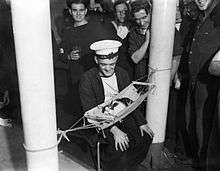
Convoy was the ship's cat aboard HMS Hermione. He was so named because of the number of times he accompanied the ship on convoy escort duties. Convoy was listed in the ship's book and provided with a full kit, including a tiny hammock in which he slept. He was killed along with 87 of his crew mates when Hermione was torpedoed and sunk on 16 June 1942 by German submarine U-205.
Emmy
Emmy was the ship's cat on RMS Empress of Ireland. She was an orange tabby cat who never missed a voyage. However, on 28 May 1914, Emmy jumped ship while in port in Quebec City. The crew returned her to the ship, but she left again, leaving her kittens behind. The Empress of Ireland left without her, which was regarded as a terrible omen.[12] She was reportedly last seen on the roof of the shed at Pier 27, watching her ship sail out of Quebec City. Early the next morning Empress of Ireland collided with SS Storstad while steaming through fog at the mouth of the St. Lawrence River and rapidly sank, killing over 1,000 people. Some have believed it's possible that Emmy may have somehow foreseen the ship's demise to be the reason why she refused to board her that day.
Felix
Felix was the ship's cat aboard Mayflower II when she set sail from Devon, England, to Plymouth, Massachusetts, in 1957 to symbolize the solidarity between the UK and the US following World War II. He was given his own life jacket and once suffered a broken paw after a mishap. The paw was set by the ship's doctor. Photos and stories about Felix appeared in National Geographic, Life, and Yankee magazine after his arrival in the US. The cat and the rest of the crew marched in a New York ticker tape parade and toured the East Coast that summer. He was eventually adopted by the cabin boy's girlfriend, Ann Berry, and settled in Waltham, Massachusetts. The current captain of the Mayflower II wrote a children's book about Felix entitled Felix and his Mayflower II Adventures. The book was published during the celebration of the ship's fiftieth anniversary at Plimoth Plantation.[13]
Halifax
Halifax was the name given to Alvah and Diana Simon's ship's cat who was found in the port of Halifax, on their way to winter at Tay Bay in 1994, on Roger Henry. The cat spent all of the time iced in on the boat with Alvah, when Diana had to leave for family purposes. Alvah's book North To The Night[14] describes his adventure in the ice with Halifax the cat, who ended up losing half an ear to frostbite.
Jenny
Jenny, the Titanic's ship's cat, was mentioned in the accounts of several of the crew members who survived the ocean liner's fateful 1912 maiden voyage. She was transferred from Titanic's sister ship Olympic and gave birth in the week before the Titanic left Southampton. The galley is where Jenny and her kittens normally lived, cared for by the victualling staff who fed them kitchen scraps.[15] Stewardess Violet Jessop later wrote in her memoir that the cat "laid her family near Jim, the scullion, whose approval she always sought and who always gave her warm devotion."[16][17] Jenny and her kittens went down with the ship.
Kiddo
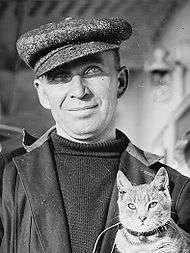
Kiddo seemed to have stowed away on the airship America, when she left from Atlantic City, New Jersey, in an attempt to cross the Atlantic Ocean in 1910. Kiddo was upset at first by the experience, but settled in and evidently, was better at predicting bad weather than the barometer. The airship's engines failed, and the small crew and Kiddo abandoned the America for lifeboats when they sighted the Royal Mail steamship Trent, near Bermuda. Kiddo then was retired from being a ship's cat and was taken care of by Edith Wellman Ainsworth, the daughter of the American journalist, explorer, and aviator, Walter Wellman, who made the daring attempt.[18]
Mrs. Chippy
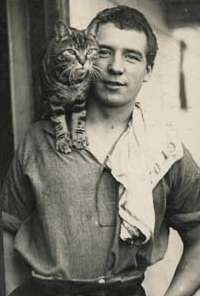
Mrs. Chippy was the ship's cat aboard Endurance, the ship used by Sir Ernest Shackleton for his Imperial Trans-Antarctic Expedition. When the ship was lost, having become trapped and eventually crushed in pack ice, Shackleton ordered the sled dogs and Mrs. Chippy shot, as Shackleton had decided that the animals could not be kept during the arduous journey ahead.
Nansen
.jpg)
Nansen was the ship's cat on Belgica, which was used for the Belgian Antarctic Expedition. He was brought on board by cabin boy Johan Koren, and was named after Fridtjof Nansen. He died on 22 June 1898,[19] and was buried in the Antarctic.[20]
Peebles
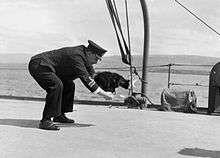
Peebles was the ship's cat aboard HMS Western Isles. Another cat who became a favourite of the ship's crew, he was known to be particularly intelligent and would shake the hands of strangers when they entered the wardroom.
Pooli
.jpg)
Pooli served aboard a United States attack transport during the Second World War. [21] She was awarded with three service ribbons and four battle stars.[22]
Rinda
Rinda was the ship's cat on the Norwegian cargo ship SS Rinda, which was torpedoed and sunk during World War II. He was rescued, along with the surviving crew by the naval trawler HMT Pict and remained on board HMT Pict, being given the name Rinda after his/her previous ship.[23]
Simon
Simon was the ship's cat of HMS Amethyst during the Yangtze Incident in 1949, and was wounded in the bombardment of the ship which killed 25 of Amethyst’s crew, including the commanding officer. He soon recovered and resumed killing rats and keeping up the crew's morale. He was appointed to the rank of 'Able Seacat' Simon and became a celebrity after the ship escaped the Yangtze and returned to Britain. He later succumbed to an infection and died shortly after. Tributes poured in and his obituary appeared in The Times. He was posthumously awarded the Dickin Medal, the only cat ever to earn the award, and was buried with full naval honours.
Tarawa
Tarawa was a kitten rescued from a pillbox during the Battle of Tarawa by the United States Coast Guard and named Tarawa. She was a mascot aboard an LST, but did not get along with the LST's other mascot, a dog named Kodiak, and jumped ship ashore.[10]
Tiddles
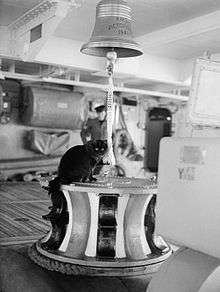
Tiddles was the ship's cat on a number of Royal Navy aircraft carriers. He was born aboard HMS Argus, and later joined HMS Victorious. He was often seen at his favourite station, on the aft capstan, where he would play with the bell-rope. He eventually travelled over 30,000 miles (48,000 km) during his time in service.
Trim
Trim was the ship's cat on a number of the ships under the command of Matthew Flinders during voyages to circumnavigate and map the coastline of Australia during 1801–03. He became a favourite of the crew and was the first cat to circumnavigate Australia. He remained with Flinders until death. A statue to Trim was later erected in his honour, and he has been the subject of a number of works of literature. A statue sits on a window sill on the outside of the State Library, in Sydney, Australia.
Unsinkable Sam
Previously named Oscar, he was the ship's cat of the German battleship Bismarck. When she was sunk on 27 May 1941, only 116 out of a crew of over 2,200 survived. Oscar was picked up by the destroyer HMS Cossack (ironically one of the ships responsible for destroying Bismarck). Cossack herself was torpedoed and sunk a few months later, on 24 October, killing 159 of her crew, but Oscar again survived to be rescued, and was taken to Gibraltar. He became the ship's cat of HMS Ark Royal, which was torpedoed and sunk in November that year. Oscar was again rescued, but it was decided at that time to transfer him to a home on land. By now known as Unsinkable Sam because of surviving the three sinking-ships, he was given a new job as mouse-catcher in the Governor General's of Gibraltar office buildings. He eventually returned to the UK and spent the rest of his life at the 'Home for Sailors'. A portrait of him hangs in the National Maritime Museum in Greenwich.
Today
The Royal Navy banned cats and other pet animals from all ships on the ocean in 1975 on hygiene grounds.[7]
Cats are still present on many private ships in modern times,[24] such as Toolbox on board the second Kalmar Nyckel.
American sailor Robin Lee Graham sailed with a number of cats on Dove and Return of Dove during his solo circumnavigation journey which began in 1965.
In fiction
There are at least two books with the title "The Ship's Cat": by Richard Adams and Alan Aldridge, and by Jock Brandis.
In a central episode in Jan de Hartog's novel The Captain, taking place on board a ship engaged in the dangerous Murmansk Convoys in the Second World War, a young officer is killed in an effort to save the ship's cat and her playful kittens during a Luftwaffe attack on the ship. This profoundly affects the main protagonist, the ship's captain, and is one of the factors leading to his later becoming a conscientious objector.
A modern, fictional example is that of Jones, from the 1979 film Alien. Lt. Ripley is so attached to a tabby cat that she makes a specific point of rescuing him from the exploding Nostromo.
In the video game Uncharted Waters: New Horizons, getting a ship's cat prevents rodent infestations and their attendant drain on food supplies.
"Below Decks" was a fictitious cat aboard the submarine USS Miami. Shortly after she was commissioned in 1990, one of the ship's radiomen with a penchant for comedic postings placed a "missing cat" poster in the ship's passageway while the ship was underway. The poster described the cat as a black and white cat, about one year old, and answering to the name "Below Decks."
A number of science fiction writers have transferred the institution of a ship's cat to interstellar spaceships of the far future. One of the earlier examples is Cordwainer Smith's short story "The Game of Rat and Dragon".[25] In her novel The Zero Stone, Andre Norton features ship cats which are also telepathic.[26] David Weber's Honorverse novels feature 'treecats' that can bond with naval officers and accompany them aboard spaceships, and at least one instance of a ship having a real cat aboard, the cat in question was a Maine Coon named Dicey. Dicey was owned by the Admiral's steward. Joe Haldeman's Forever War also features a ship's cat.
Spot, a cat owned by Lt. Commander Data in Star Trek: The Next Generation, could be considered the ship's cat of the Enterprise-D, despite not being the only cat aboard the ship.
Cat, from the British sci-fi sitcom Red Dwarf, is another example. The character has no name other than "The Cat" or simply "Cat". He is the humanoid descendant of a modern domestic cat called Frankenstein who had been Dave Lister's pregnant pet cat. He may be the last remaining member of his species, Felis sapiens.
The children's book The Mousehole Cat by Antonia Barber tells the story of a cat who owns an old Cornish fisherman who accompanies him on sea voyages.
In the Arthur Ransome book We Didn't Mean to Go to Sea, a shipwrecked kitten becomes the ship's cat of the "Goblin". Named Sinbad after the fictional sailor of that name, the cat also appears in the next book in the series, Secret Water.
In an episode of Gomer Pyle, U.S.M.C., Gomer brings a pregnant cat on board a navy ship while on sea maneuvers.
Fish Head is the eponymous character in a 1954 children's book by Jean Fritz, a cat who is known in a fishing town for stealing fish from the local market. He accidentally ends up aboard a ship in an attempt to flee the angry store clerk. While at sea, he tangles with the captain and struggles to earn his 'sea legs', and in the end, becomes a member of the crew.[27]
In Scott Lynch’s Red Seas Under Red Skies, sailors' superstition is such that they will mutiny against a captain who brings no cat on their ship.
Tom Cat of the Tom and Jerry franchise was sometimes portrayed as a ship's cat in a few episodes, and so had other cat-characters of the franchise.
The Alan Lewrie series of books written by Dewey Lambdin prominently features three cats as the pets of Captain Alan Lewrie, RN. The first, William Pitt, is inherited by Lewrie when he takes command of his first ship.[28] Toulon, his second cat, is a remembrance of Lewrie's narrow escape from the carnage of Toulon during the early part of the Napoleonic Wars. His third cat, Chalky, is a gift from his half-Indian son.
See also
- The Adventures & Brave Deeds Of The Ship's Cat On The Spanish Maine (Children's book)
- Gallico, Paul, Jennie (novel).
- Norwegian Forest cat
References
- ↑ Bruzelius, Lars (2005). "Sailing Ships". Stevens: ‘Vermin’, 1894. The Maritime History Virtual Archives. Retrieved April 20, 2010.
- ↑ "Paintings from the Tomb-chapel of Nebamun". Khan Academy. Retrieved 25 July 2017.
- ↑ "Simon of HMS Amethyst", Purr’n’fur, UK.
- ↑ Briggs, Helen (19 June 2017). "How cats conquered the ancient world". BBC News. Retrieved 19 June 2017.
- ↑ "Cats sailed with Vikings to conquer the world, genetic study reveals". www.sciencealert.com. Science Alert. 23 September 2016. Retrieved 3 October 2016.
- ↑ Eyers, Jonathan (2011). Don't Shoot the Albatross!: Nautical Myths and Superstitions. A&C Black, London, UK. ISBN 978-1-4081-3131-2.
- 1 2 Famous ships cats and their lives, UK: Purr’n’fur.
- ↑ "Cats", Royal Navy (book), UK: R Jerrard.
- ↑ Fred Glueckstein. "Churchill’s Feline Menagerie". The Churchill Centre. Retrieved 19 July 2014.
- 1 2 "Mascots", History, US: Coast Guard.
- ↑ "Ship’s cat (Chibbley)" (interview). Be World Wise. Archived from the original on April 9, 2007.
- ↑ Blatchford, Andy (23 May 2014). "Empress of Ireland, ‘Canada’s Titanic,’ finally getting its due after 100 years". The Globe and Mail. The Canadian Press. Retrieved 7 January 2015.
- ↑ "Felix", The Journey of the Mayflower II, Plimoth.
- ↑ Simon, Alvah (1998). North to the Night: A Year in the Arctic Ice. Camden, ME: McGraw-Hill [u.a.] ISBN 0-07-058052-9.
- ↑ Eaton, John P.; MacQuitty, Charles A. Haas ; foreword by William (1999). Titanic: A Journey Through Time. Sparkford: Patrick Stephens. p. 234. ISBN 1-85260-575-8.
- ↑ Pellegrino, Charles (2012). Farewell, Titanic : her final legacy. Hoboken, N.J.: Wiley. p. 29. ISBN 0-470-87387-6.
- ↑ introduced, Violet Jessop ;; edited,; Maxtone-Graham, annotated by John (2004). Titanic survivor: The newly discovered memoirs of Violet Jessop who survived both the Titanic and Britannic disasters (1st pbk. ed.). Dobbs-Ferry, NY: Sheridan House. ISBN 1-57409-184-0.
- ↑ Janus, Allan (October 15, 2005). Animals Aloft: Photographs from the Smithsonian National Air & Space Museum. Bunker Hill Publishing. ISBN 1-59373-048-9., 128 pp.
- ↑ Lewis, Val (2002). Ship's Cats in War and Peace. Shepperton: Nauticalia. pp. 59–60. ISBN 0-9530458-1-1.
- ↑ de Gerlache, Adrien, Belgica Belgian Antarctic Expedition 1897–1899, Cool Antarctica, retrieved 5 October 2010
- ↑ "Changing Times: Los Angeles in Photographs, 1920–1990 (Pooli, cat who served aboard an United States attack transport during World War II celebrates 15th birthday)", The Los Angeles Times (photograph), UCLA, July 4, 1959.
- ↑ "Cats in the Sea Services". www.usni.org. U.S. Naval Institute.
- ↑ "D/S Rinda". War sailors. Retrieved 7 February 2012.
- ↑ Chibbley's travels aboard Barque Picton Castle
- ↑ Smith, Cordwainer (October 1955), "The game of Rat and Dragon", Galaxy Science Fiction, Project Gutenberg.
- ↑ Norton, André, Zero stone, Amazon.
- ↑ Fritz, Jean, "Fish head", Kirkus reviews.
- ↑ The Kings Commission
- Lewis, Val (2001). Ships' Cats in War and Peace. Nauticalia. ISBN 978-0-9530458-1-5.
- Roberts, Patrick. "Simon". Famous Felines. Purr-n-Fur.
External links
| Wikimedia Commons has media related to Ships' cats. |
- "Cats: At sea". Wyrdology.
- "Cats in the sea services". USNI.
- "Famous Naval Cats: War". Purr’n’fur. UK.
- "Ship's cats". Moggies. UK..
- "The Ship's Cats that Lapped and Mapped the World". Seafurrers. Australia.